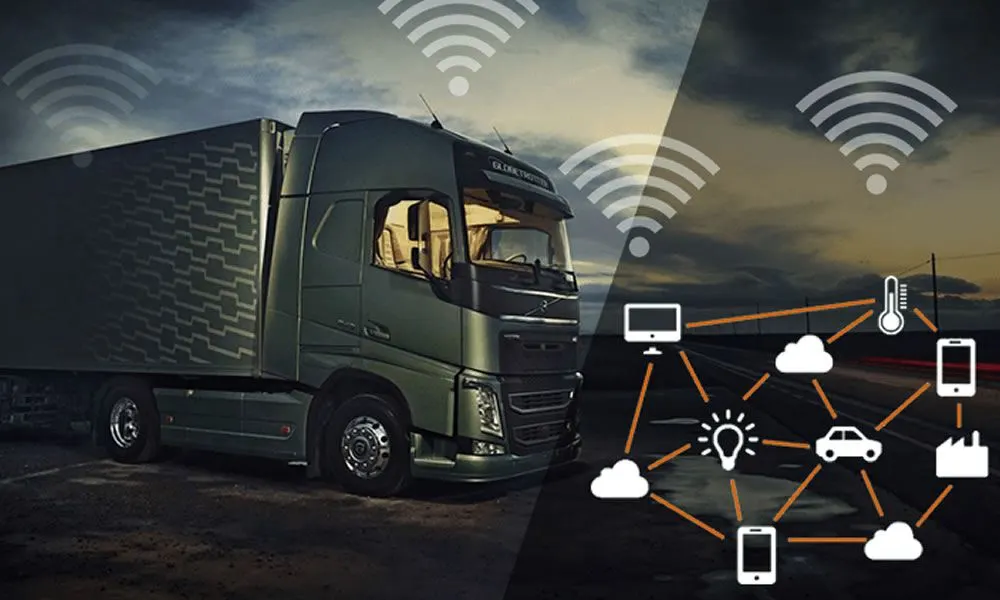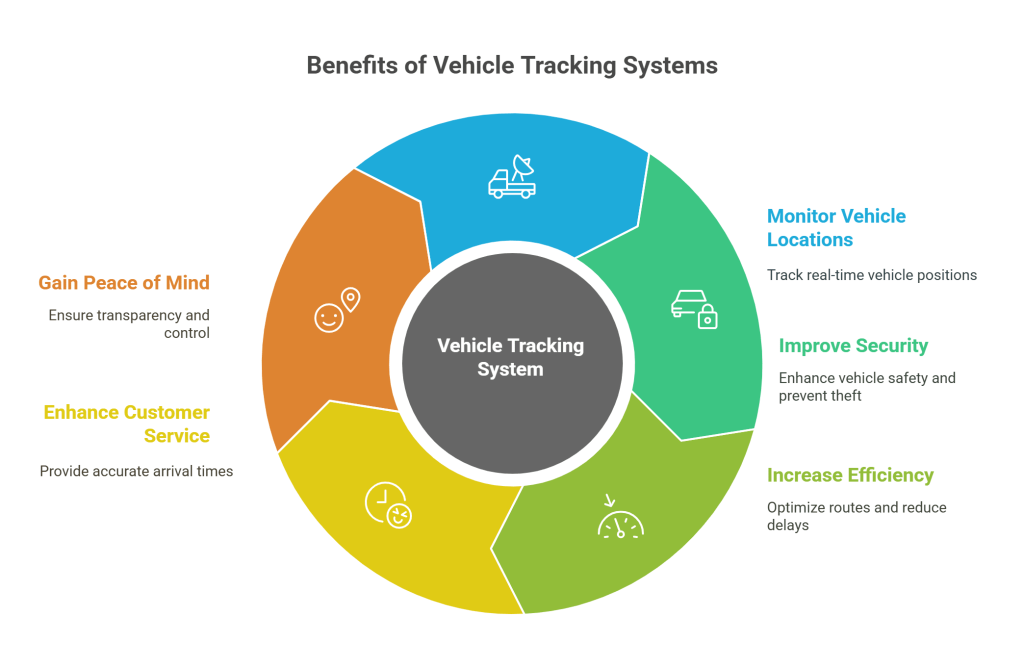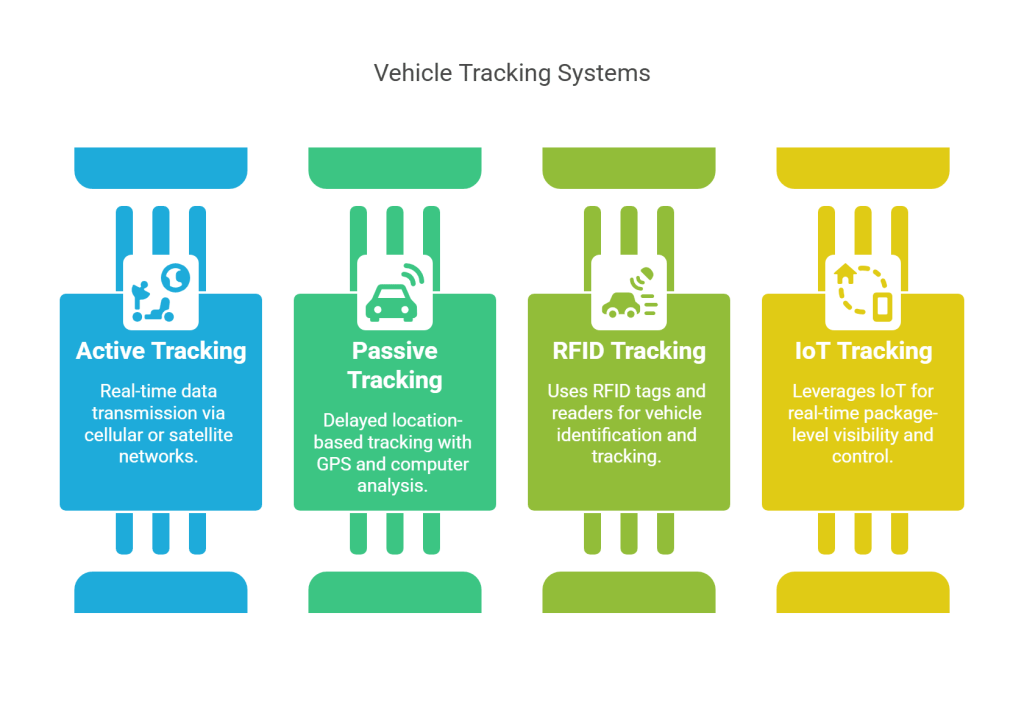As a business manager, how do you track your vehicles and fleet? Vehicle tracking can be a daunting task. In such a scenario, a vehicle tracking system may be the answer to all your worries. But, how will a vehicle tracking system contribute to your business? Moreover, what are the various types of vehicle tracking systems, and which one is the best for you?
Let’s dive in to explore the vehicle tracking system and its various types in detail.

Vehicle Tracking System: What Is It?
A Vehicle Tracking System (VTS) is a system that helps manage and track the location of your vehicles. These systems work by connecting the fleet management software with the in-vehicle telematics, which allows the system to gather information both about the vehicle and its driver.
The fleet tracking software tracks data related to field operations processes, whereas the in-vehicle telematics automatically transmits the data or information using GPS or GLONASS technology.
Besides the location of the vehicle, it also tracks other parameters associated with the vehicle and driver, such as engine management, vehicle diagnostics, driving hours, speeding, excessive idling, etc.
In short, a vehicle tracking system allows businesses to monitor their vehicle anywhere and anytime. For businesses, a vehicle tracking system plays a pivotal role in fleet management, monitoring driving behavior, and theft prevention.
Why Does Your Business Need a Vehicle Tracking System?
Did you know that a report published by Allied Market Research claims that the vehicle tracking system is set to grow from $17.37 billion in 2020 to $109.95 billion by 2030? This might lead you to think why you need a vehicle tracking system for your business.
If you own or manage a business that relies on a fleet of vehicles, like a taxi firm, logistics company, or delivery service, then the thought of investing in a vehicle tracking system has probably crossed your mind.
Vehicle tracking systems provide invaluable insight into where your vehicles are at all times and can help you create more accurate estimated arrival/pickup times for customers as well as increase overall vehicle security.
With a vehicle tracking system, an employee can no longer lie to you about their location or route taken since all movements are visible on a map. Investing in this technology will give you greater peace of mind knowing that the whereabouts of your business vehicles are just a few clicks away.
Benefits of Vehicle Tracking System

Vehicle tracking systems come with a lot of benefits that make fleet management a cakewalk. Let’s discuss the benefits of the fleet management system in detail :
1. Improved visibility and traceability
A vehicle tracking system provides you with real-time updates about your vehicles and the drivers. Starting from engine management and vehicle diagnostics to driving behavior, all the real-time updates are available at your fingertips. This improves the visibility and traceability of your fleet within the supply chain.
2. Increased efficiency
Besides monitoring your vehicle, you can also control and manage other essential parameters, such as fuel management. Moreover, these systems are integrated with extensive telematics functions, which help you keep an eye on other essential details like engine temperature indicators and your vehicle’s health, in general.
Thus, a vehicle tracking system not just tracks your fleet details but also assists you in inspecting and optimizing it, thus reducing costs and increasing efficiency.
3. Secure Assets
As a smart business manager, you must ensure the safety of your inventory and assets, ensuring they are not lost or stolen during transit. With a vehicle tracking system, your assets can be tracked just with your vehicle, thus ensuring their safety.
4. Improved Driver Management
You can use a vehicle tracking system to monitor driver behavior as well. This allows you to ensure that they are taking the safest routes and not engaging in any unsafe driving behaviors such as speeding or sudden braking. You can also set up alerts to notify you if a vehicle strays off the designated route or exceeds a speed limit.
5. Improved customer service
With a vehicle tracking system, you no longer need to provide an estimated date of delivery to your customers. Instead, you can track how far your vehicle is from the customer’s destination and provide them with an accurate time of delivery. This way, the chances of late delivery are also reduced.
Types Of Vehicle Tracking System

There are various types of vehicle tracking systems. Let’s explore and understand each of them.
1. Active Vehicle Tracking Systems
Active Vehicle Tracking Systems include those vehicle tracking systems in which devices are installed in a vehicle to collect and transmit data from the vehicle in real-time. The data is stored in a central server which can then be accessed via software.
These tracking systems usually involve placing a device inside or on the vehicle, connecting it to a power source, and then setting up a connection between the device and either cellular technology or satellite technology for transmitting the data. There are two types of active vehicle tracking systems:
Cellular Tracking:
Cellular tracking system is an active vehicle tracking method in which cellular networks are used to transmit the tracked data. It works by sending data packets from the device to a cellular tower, which then forwards to a service provider or monitoring center over an internet connection.
As they use cellular data, they are functional even in locations that don’t have cellular coverage or access to the internet. The best part about them is they are easy to install and the price is affordable.
Satellite-based Tracking System:
In the satellite-based tracking system, satellite networks are used for the transmission of collected data. This involves using a GPS device on board the vehicle and connecting it to a satellite network.
The best part about this system is that you can also use them in remote areas. But , they are not easy to install and are on the expensive side. However, these systems are known for their exceptional accuracy.
2. Passive Vehicle Tracking Systems
Passive vehicle tracking systems include those vehicle tracking systems which use GPS to track vehicles’ locations. Unlike the active vehicle tracking system, you can’t get real-time updates in a passive system. Also known as “delayed location-based tracking”, it requires the installation of Passive GPS trackers in the target vehicles.
Once the GPS trackers are installed in the vehicles and connected to the computer, users can view the data on the computer. In comparison to active tracking systems, the passive systems are more affordable.
Moreover, they are easy to set up, affordable, and don’t require a continuous power supply, which is why they are perfect for keeping an eye on your drivers and fleet without their knowledge.
3. RFID-Based Package Tracking Systems
RFID-Based Package Tracking Systems are those systems that use RFID (Radio-Frequency Identification) tags and electromagnetic readers for vehicle tracking. RFID systems use three components to transmit data: RFID tags or smart labels, an RFID reader, and an antenna.
Each vehicle is assigned and connected to a unique RFID tag which contains a small integrated circuit to transmit data to the interrogator (reader). The reader converts the radio waves into digital information that can be processed by a computer system. Readers can be fixed or mobile; fixed readers are typically used in warehouses and other stationary locations, while mobile readers are used to tracking items on the move.
4. Package-Level Tracking Using a Hybrid IoT System
IoT-enabled package-level tracking solutions provide companies with real-time visibility and control on the parcel level, leveraging GPS, GSM, WIFI, and Bluetooth systems. This enables them to find the most optimal route for delivery, saving both time and fuel.
The IoT tracking system also allows businesses to remotely monitor their shipments, providing full visibility into their shipping operations. Further, it facilitates faster decisions and timely delivery by tracking chain-of-custody documents across transportation modes.
Additionally, companies benefit from real-time data insights and improved decision-making as well as operational efficiencies with the help of multi-carrier communication and package condition monitoring solutions.
How Can QodeNext’s TITO Help You in Vehicle Tracking?
QodeNext’s TITO is a comprehensive truck management solution designed to optimize vehicle tracking and scheduling across facilities. Using RFID, BLE, and IoT technologies, TITO provides enhanced visibility and control of truck movements, improving the functionality and reducing operational costs.
The system can help you automate the check-in process to minimize bottlenecks, optimize the movement of trucks, reduce rental costs due to improved truck turnaround time, and decrease pilferage at the weighbridge.
With TITO, you can expect improved turnaround time by up to 30%, enhanced trust with biometrics, live dashboards, and maps for increased visibility, advanced situational awareness with automated IIOT devices, integration with ERPs, reduced manpower monitoring processes, and improved driver awareness.
TITO is the perfect solution to optimize vehicle management, enhance visibility and increase operational efficiency. Enjoy the benefits of improved vehicle tracking today with TITO by Qodenext.
Conclusion
Vehicle tracking systems greatly improve the efficiency of your vehicles, fleets, and other assets. By using GPS or RFID technologies, you can monitor the location of your vehicles in real-time, track mileage, and optimize routes for better fuel efficiency.
With the help of these systems, you can now ensure the safety and security of your vehicles and reduce the costs associated with lost or damaged assets. Investing in a good vehicle tracking system is an excellent way to improve fleet management and provide better service to customers.
While we’re discussing a good vehicle tracking system, don’t forget to check out QodeNEXT’s amazing solution named TITO.
FAQs: Vehicle tracking system
1. What is a vehicle tracking system?
A Vehicle Tracking System (VTS) is a system that helps you manage and track the location of your vehicles. Besides the location, it also tracks other parameters associated with the vehicle and driver, such as engine management, vehicle diagnostics, driving hours, speeding, excessive idling, and more.
2. What are the types of vehicle tracking systems?
There are four types of vehicle tracking systems:
- Active vehicle tracking systems (Cellular Tracking and Satellite-based Tracking)
- Passive vehicle tracking systems
- RFID-based package tracking systems
- Package-level tracking using a hybrid IoT system
3. How does the active vehicle tracking system differ from the passive one?
The key difference is that active systems provide real-time updates, while passive systems record and store data for later analysis, without real-time transmission.
4. What are the types of active vehicle tracking systems?
There are two main types:
- Cellular tracking systems, which use mobile networks to transmit data in real time
- Satellite-based tracking systems, which are ideal for remote or off-grid locations where cellular coverage is limited
5. How does QodeNext’s TITO help you in vehicle tracking?
TITO by QodeNext enhances visibility and control over truck movements. It automates check-in processes, minimizes delays, optimizes truck routing, reduces rental costs by improving turnaround time, and curbs pilferage at weighbridges.
6. How does a vehicle tracking system improve efficiency?
By monitoring vehicle health and driver behavior, optimizing routes, reducing idle time, and minimizing fuel consumption, a vehicle tracking system significantly boosts fleet efficiency.
7. Is satellite tracking better than cellular tracking?
Satellite tracking provides wider coverage and higher accuracy, especially in remote areas. However, it is typically more expensive than cellular tracking.
8. Can vehicle tracking systems prevent theft?
Yes. Vehicle tracking systems provide real-time location data and instant alerts, which help in the quick recovery of stolen vehicles and assets.
9. Are passive tracking systems reliable?
Passive tracking systems are reliable for capturing data but lack real-time monitoring. They’re best used for post-trip analysis or in areas with limited network access.
10. What businesses benefit from vehicle tracking systems?
Businesses such as taxi services, logistics providers, courier and delivery companies, construction firms, and any organization with a fleet of vehicles can benefit significantly from vehicle tracking systems.
11. How do RFID systems work in vehicle tracking?
RFID tags attached to vehicles or cargo transmit data to fixed or mobile RFID readers. This enables efficient monitoring and movement tracking without requiring active input from the vehicle.
12. What is IoT vehicle tracking?
IoT vehicle tracking uses a combination of wireless technologies (e.g., GPS, GSM, RFID, Bluetooth) to deliver real-time, end-to-end tracking of vehicles and shipments with detailed insights.
13. Can vehicle tracking improve customer satisfaction?
Absolutely. By offering accurate delivery timelines, minimizing delays, and enabling proactive communication, vehicle tracking improves customer trust and satisfaction.






